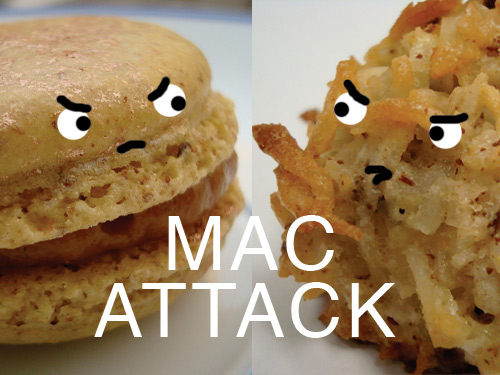 It's a true cookie mystery: what's the deal with macarons and macaroons? After all, their names are very similar, but the cookies are seemingly very different: one is a refined, Frenchie sweetburger, and the other a frumpy lump of coconut flakes.
It's a true cookie mystery: what's the deal with macarons and macaroons? After all, their names are very similar, but the cookies are seemingly very different: one is a refined, Frenchie sweetburger, and the other a frumpy lump of coconut flakes.
But you know what? They are in fact related. While they may not be part of the same immediate family, they definitely come from the same family tree. Here's an excerpt from a CakeSpy post on macaroons which was originally posted in April 2008.
The Macaron: While there is evidence of meringue-type cookies going as far back as the 1500s, as I learned from Wikipedia, the macaron in its current form is generally accepted as taking shape in the late 1700s when two Benedictine nuns, Sister Marguerite and Sister Marie-Elisabeth were seeking asylum in the town of Nancy during the French Revolution, and paid for their housing by baking and selling the macaron cookies. However, these original macarons were simply cookie rounds--it wasn't until the 1930s that fancy tea room Ladurée began serving the cookies in a new way, with a sweet ganache filling between two of the traditional rounds. Naturally, the sweet filling and flavor and texture contrast caught on, and the l'il Luxembourgers began to take the world by storm (read more about the Frenchie ones in this fantastic writeup by one of my favorite foodies, Robyn Lee).
The Macaroon: However, veering on a different path than Ladurée, as I learned from The Nibble, the cookie also gained popularity with the Italian Jewish population because it requires no flour or leavening (the agent that raises and lightens a baked good, like yeast, baking powder and baking soda—instead, macaroons are leavened by egg whites) and can be enjoyed during Passover. Naturally, due to a high level of deliciousness, it gained popularity all over Europe as a year-round sweet, and regional variations popped up. The coconut macaroon seems to have gained popularity first in Glasgow, Scotland; it is most likely from here that it hopped over the pond and captured the hearts of Americans.
So, there you have it--the story of one humble cookie which has taken two very different paths--with countless other small variations on both styles. Of course, as with so many things, this knowledge is best applied with real-life experience, and so I suggest you eat one of each, macaroon and macaron, as soon as possible.
